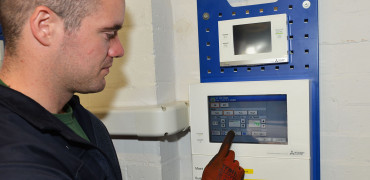It is quite common to find that building services equipment is supplied with its own controls. These can have varying levels of sophistication, but generally this type of equipment is referred to as ‘smart kit’.
In many buildings, individual pieces of building services equipment will often be connected, via their controls, to a building-wide network known as the building energy management system (BEMS).
A BEMS coordinates the operation of various equipment in the building such as boilers, ventilation, lighting and cooling.
It can also gather information from sensors that track light, occupancy, temperature or CO2 and use these to optimise the operation of cooling, lighting, heating etc.
Understanding the benefits of controls is important and can have a significant impact on energy use.
Open protocols
For facilities managers, the BEMS can provide a front-end software interface allowing a single point of information on how the building services are performing. The front-end software comes in many forms, and the latest BEMS can deliver information to hand-held devices via the Internet.
One important aspect of smart kit and BEMS is the concept of ‘open protocols’. These are the most common ‘languages’ used in programming building controls, and they allow different types of equipment to communicate more easily.
There are several open protocols in use, including Modbus, BACnet, LonWorks and KNX. Some of these have been designed to work specifically with certain types of equipment such as energy meters.
Linking smart kit to wider BEMS
If you are thinking of linking your smart kit to the wider BEMS, then it is a good idea to ensure that the equipment is capable of communicating with one (or more) of these protocols. One recent development from Mitsubishi Electric has been the introduction of MelcoBEMS.
This is an air conditioning interface that is compatible with BACnet and Modbus enabled products. This interoperability gives users the flexibility to get the best out of their systems and their buildings - including comprehensive energy monitoring and reporting to help save energy and therefore running costs, whilst also creating comfortable environments for occupants.
Whether a building has simple or sophisticated controls, understanding their benefits is important because they can have a significant impact on energy use. There is a Standard that can identify the potential energy savings of a wide range of generic building controls, and their impact on energy use in several different types of building.
The Standard
BS EN 15232 (2012): Energy Performance of Buildings - Impact of Building Automation, Control and Building Management (LINK TO GUIDE) is the result of research carried out in support of the European Energy Performance of Buildings Directive (EPBD) (LINK TO GUIDE). For anyone trying to calculate the cost-benefits of building controls it is an invaluable tool.
It is a European and British Standard that provides a structured list of controls and building automation technologies which have an impact on the energy performance of buildings.
The document introduces four efficiency classes and deals with a range of controls products such as automatic detection devices, demand-based controls such as CO2 sensors, and also controls-based strategies, for example night cooling.
It also gives a method to define minimum requirements for building controls for buildings of different complexities. Most usefully, the Standard provides detailed methods to assess the impact of building controls on the energy performance of a given building.
How the Standard can be used
The Standard can therefore be used to demonstrate the energy savings of different types of building control, to compare against the costs.
For clients and specifiers, BS EN 15232 can be used to identify levels of control required in a new building, or refurbishment project - the Standard identifies four classes A, B, C and D of building control, giving estimates of how much energy is saved at each level.
In terms of calculating the impact of these different classes of control, BS EN 15232 offers real insight, based on extensive modelling of different types of buildings such as offices, hospitals, schools, lecture halls and retail buildings.
With class C controls taken as 'standard', the amount of energy saved compared to this level is shown for each building type.
IoT - the next step for smart kit
The Internet of Things (IoT) points the way to a future where everything is IT based and we communicate and store things ‘in the cloud’. By linking building services equipment to the Internet, the very latest equipment is reaching new levels of intelligence and access.
Remote Monitoring Interface (RMI) and MELCloud from Mitsubishi Electric are examples of Wi-Fi app interfaces that can remotely monitor and control a range of air conditioning and heating equipment.
RMI is a great solution for facilities managers offering cloud-based management of HVAC equipment, diagnostics, continuous monitoring and the ability to predict potential operational issues to minimise the need for field interventions and maximise efficiency.
MELCloud is ideal in retail networks with small to medium outlets as it provides multi-site control and group control plus estate-wide central control which allows a global command to be created and distributed to all outlets by one touch of a smartphone app.
MELCloud is also great for homeowners as it connects to their renewable heating system giving them immediate access and control, wherever they are.
MELCloud also allows for remote maintenance and technical support via a service called MELConsole. This highly intelligent maintenance service allows Mitsubishi Electric engineers to remotely interrogate and often fix a homeowners heating issue without needing a visit.
Users of both these Wi-Fi solutions can also observe equipment operation, and receive messages about errors through PCs, Tablets or Smartphones (the apps can be purchased for free in all app stores). These solutions, along with the rest of the Mitsubishi Electric range of controls can support a variety of control strategies including night cooling and limiting setpoints.



